Saltbox house
A saltbox house is a traditional New England style of house with a long, pitched roof that slopes down to the back, generally a wooden frame house. A saltbox has just one story in the back and two stories in the front. The flat front and central chimney are recognizable features, but the asymmetry of the unequal sides and the long, low rear roof line are the most distinctive features of a saltbox, which takes its name from its resemblance to a wooden lidded box in which salt was once kept.
Origins
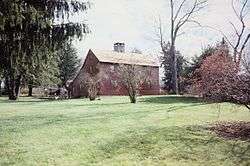
The saltbox originated in New England and is an example of American colonial architecture. Folklore holds that the saltbox form was popularized by Queen Anne's taxation of houses greater than one story. Since the rear of the roof descended to the height of a single-story building, the structure was exempt from the tax.[1] Actually, the saltbox shape evolved organically from the need for additional space for growing families; adding a lean-to was an economical way to enlarge the house. All but two of the examples below predate Queen Anne.
The roof style is also known as a catslide roof – any roof that, on one side, extends down below the main eave height, providing greater area under the roof without an increase in the ridge height.[2]
The earliest saltbox houses were created when a lean-to addition was added onto the rear of the original house, extending the roof line sometimes to less than six feet from ground level. Old weathered clapboards are still in place on parts of the original rear exterior walls of some of the earliest New England saltbox houses (see images). The hand-riven oak clapboards on both the Comfort Starr House and Ephraim Hawley House are preserved in place in the attic that was created when the lean-to was added onto the original house. The style was popular for structures throughout the colonial period and into the early Republic, perhaps because of the simplicity of its design.
Saltbox homes can also be found in parts of Newfoundland and Labrador.
Construction
Most early saltboxes, as with many other types of New England colonial houses, are timber-frame. Timber framing, or post-and-beam construction, involves joining large pieces of wood with woodworking joints, such as mortise-and-tenon joints, or with wooden pegs, braces, or trusses. Metal nails were sparingly used, as they were an expensive commodity at the time. The exterior of a saltbox was often finished with clapboard or other wooden siding. The Josiah Day House in West Springfield, Massachusetts, is constructed of brick.[3]
Images
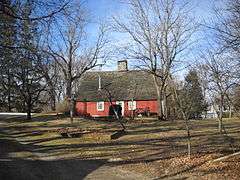 Ephraim Hawley House, Nichols, Connecticut catslide rear roof
Ephraim Hawley House, Nichols, Connecticut catslide rear roof- Ephraim Hawley House, Nichols, Connecticut; original oak clapboards in lean-to attic
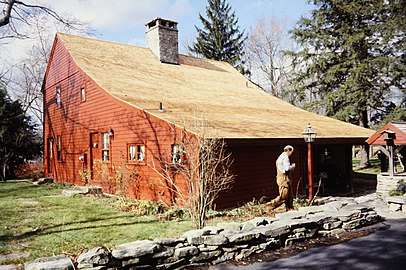 Catslide roof Thomas Hawley House
Catslide roof Thomas Hawley House c. 1643 Edmund Rice homestead in Sudbury (now Wayland, Massachusetts), destroyed by fire ca 1912
c. 1643 Edmund Rice homestead in Sudbury (now Wayland, Massachusetts), destroyed by fire ca 1912- c. 1651 Macy-Colby House, Amesbury, Massachusetts
- c. 1683 Ephraim Hawley House, Nichols, Connecticut
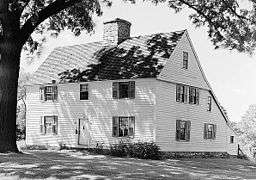
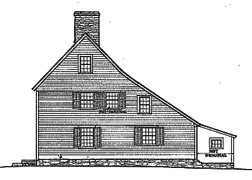 Side elevation of c. 1695 Comfort Starr House illustrating the distinctive roof line
Side elevation of c. 1695 Comfort Starr House illustrating the distinctive roof line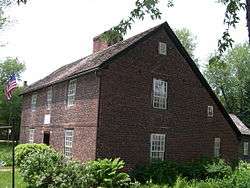 c. 1754 Brick Josiah Day House West Springfield, Massachusetts
c. 1754 Brick Josiah Day House West Springfield, Massachusetts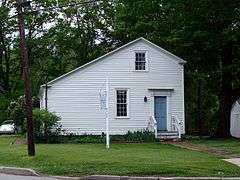 c. 1838, Sturgeon House, Fairview, Pennsylvania
c. 1838, Sturgeon House, Fairview, Pennsylvania
See also
References
- "The Salt-Box House.; Books of the Season". The New York Times. December 22, 1900. Retrieved April 27, 2008.
- "Roof options for your oak-framed building". ehbp.com. English Heritage Buildings. Retrieved 19 October 2017.
- "Joshua Day House Museum". west-springfield.ma.us. West Springfield, Massachusetts. Archived from the original on 2010-03-09. Retrieved 2009-07-19.
External links
- Saltbox Houses in the Historic American Buildings Survey
- Timber-frame Houses in the Historic American Buildings Survey
- Early Connecticut Houses: An Historical and Architectural Study By Norman Morrison Isham, Albert Frederic Brown
.jpg)